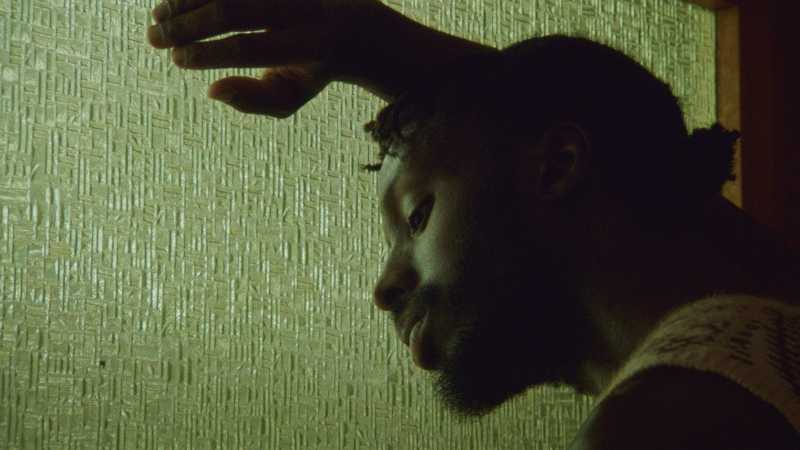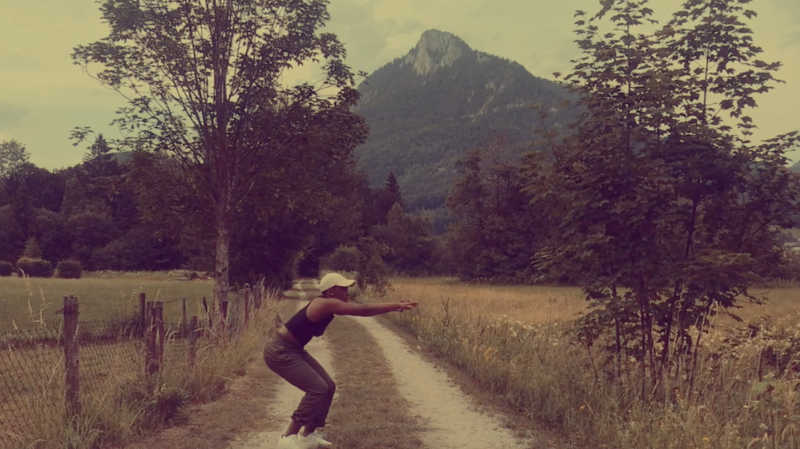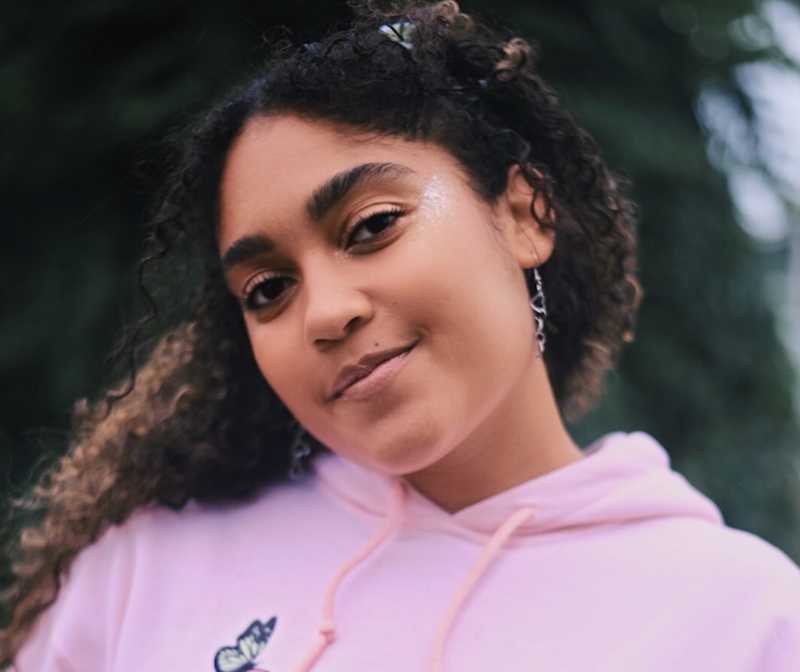I joined dancers Israel Harris and Hiroka Nagai in a conversation on the creative process of my most recent contemporary dance work, strikethrough, which premiered at the Jack Crystal Theater at NYU Tisch School of the Arts in March 2020. The work combined original music, lighting, and costumes with projected animations and the two dancers’ executions of a choreographic score, entitled “strikethrough #1.”
The score — distributed to audience members in the form of a pamphlet — is arranged like a poem and occurs in five segments, each succession undergoing a process of erasure called strikethrough. As the phrases within the poem gradually diminish, instructions appear on the right-hand side, as if highlighting what’s being taken away. Since our first studio rehearsals in late 2019, I used the score as a guide for how the dancers would move and interact with each other on stage. The instructions served as moments for the dancers to exercise their own choices within the duet, so in theory they could live within a structure of infinite mutability, where — like the act of strikethrough upon the poem — all possibilities are in place.
Having been on the inside of a choreographed erasure, the dancers both considered their own movement invention as an integrative part of the creative process. “Most of the choreographers I work with have set choreography where they know the end result,” Nagai said, whereas with strikethrough, “we had much more leeway in how the choreography was performed.” She compared it to a choreographer giving a dancer a word to work with, versus an entire phrase or sentence from a poem, implying that this process established more space between the choreographer’s directives and what the dancer eventually generated. “There was more room to abstract the language,” she said.
“Everybody’s choreographic process differs depending on the project or the dancers,” Harris said. “Working in a way that gives dancers autonomy is really exciting for movement creation; it’s different than teaching movement and steps. I like the idea of a process that has the ability to adapt.” In relation to the designated line breaks and instructions of the strikethrough score, he spoke of constraints as a way to help people who want to approach creation without knowing the end result.
In the efforts of continuing the project as an exploration into modes of choreographic composition, I initiated a virtual collaboration with the dancers as an alternative to our work in the studio. I provided them with a version of the score (above), and had them create and film two movement phrases, one original (I.) and one that used the strikethrough instructions as a way to erase segments of the original phrase (II.).
“It’s just different, not harder,” Nagai said, towards accomplishing the tasks in the quarantine. “Explaining what you wanted from us added more depth to the work.” My decision to have the dancers interact first-hand with the text as opposed to my in-person instructions created an ideal paradigm under which the strikethrough score could operate; movement tasks could be completed based on each dancer’s individual relationship with the sequence of language.
“Doing it on our own versus doing it in the studio was the same,” Harris said. “You work a lot differently when you have bodies in the room with you,” but in this context, “I played with a voice in my head, thinking that we were still in the space.”
As we examined ways that the strikethrough score could be directly applied from a composition exercise to the process of staging choreography, Nagai noted that “the composition exercises made [the material] easier to approach. It’s harder going into something when it has to be onstage and ‘good.’”
Over the course of this project, regardless of its performative mutations, I’ve wanted to address it as a creative process without ends. The way one looks at the score itself is an encounter with memory — its permutations etched across the vanishing segments — in a fate where we often don’t choose what leaves us and what remains.
“I don’t immediately go back to composition class when I create something,” Harris said. “There’s a formality to going back to the past. In practice it takes a different form.” And as such, our use of the score evolved in the studio as I arranged the pure material into miniature duets in conversation with the rotation of clips provided by our animator, Jade Lien, to be projected onto the theater backdrop.
One of Lien’s animations consisted of a rice-paper star, with letters bubbling out of each of its spokes. It fascinated me to work with its qualities of cloudy, formless expanse, a circulating grey veil eventually zooming into complete white. During this sequence, the dancers transitioned from floor to standing in a swirling pattern, to then burst out running like revolving planets, to slowly spatially condense into a tiny phrase of thirty-four gestures.
We also varied the process from the restrictions of the score in response to the ambient electronic sketches sent by our composer, Alex Mackinnon, that would in time accompany the performers on stage. Harris first brought up the image of orbiting stars upon hearing a section of Mackinnon’s score, and Nagai mentioned bubbles rising to the top of a fish tank and popping upon surfacing. I myself heard the keys of a typewriter being pressed.
It worked similarly with Hamilton Guillén, our lighting designer, who first approached me to discuss how this idea of strikethrough was like old films with scenes missing that are now stitched together. Per the suggestion of our costume designer, Eszter Retfalvi, to have draped ivory sleeves, like the loosened pages of a book, Guillén mentioned that a cream color lighting would create this nostalgia associated with old treasures. All of a sudden a dry movement score had the potential to become a living archive, a readable art.
I was curious to learn from the dancers how an artist might arrive at this idea of strikethrough as a traceable process of erasure. One experiment I’ve already pursued is the video overlay of the two distinct phrases to illustrate the moments at which phrase II. fades in and out of phrase I.
Harris mentioned the peculiarity of how even though the task was to omit material, his phrase II. remained longer than phrase I, as if phrase II. was actually meant to capitalize on the remnant of what was there. “This idea of accumulation is an interesting choreographic tool to witness,” he said, giving examples like cannoning, and arranging the phrases in numbered lines and reading them out.
We then discussed how the strikethrough scores may serve as a compositional tool for various forms of the visual and performing arts. In response to the forthcoming website [developed by Troy Kelley; currently only available on desktop devices] that will enable users to generate and download their own strikethrough score, we wanted to ask how an interactivity with poetic forms might benefit today’s artist community.
“Artists generally are interested in different mediums,” Harris said, “and language is how people can communicate. It can become a useful tool for what people incorporate into their practice.” He referenced postmodern choreographer, Merce Cunningham’s collaborations with composer, John Cage, on his experimental sound scores, as well as contemporary choreographer, Wayne McGregor’s collaboration with cognitive scientists on creating phrase material out of mental imagery tasks.
“The score builds bridges for people who aren’t movers or people who practice different types of art,” Nagai said. “It extends past people in the dance community.” This was my primary goal in the interdisciplinary nature of the project, having fostered collaborations among designers, dancers, a composer, an animator, and recently a coder. The visual potential of the score — its segmented nature, its omit/insert instructions, its erased phrases — created a communal space where ideas about book arts, poetry, erasure, and choreography could intermingle among artists whose focuses remained disparate.
Throughout the course of this research, choreographic and otherwise, I’ve discovered that strikethrough wants to be an artist’s tool for composition. Unlike blackout poetry, the strikethrough score and its associated choreography enable us to see what remains visible in a succession of erasing, to revisit what has become formless in our continued search for form.
A gracious thank you to Hiroka and Israel for joining me on this journey towards what remains of the visible in an overwhelming sea of invisibles, and to all collaborators who brought this work to light.





